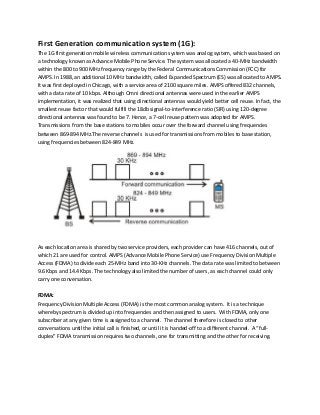
1st generation communication system.
- 1. First Generation communication system (1G): The 1G first generation mobile wireless communication system was analog system, which was based on a technology known as Advance Mobile Phone Service. The system was allocated a 40-MHz bandwidth within the 800 to 900 MHz frequency range by the Federal Communications Commission (FCC) for AMPS. In 1988, an additional 10 MHz bandwidth, called Expanded Spectrum (ES) was allocated to AMPS. It was first deployed in Chicago, with a service area of 2100 square miles. AMPS offered 832 channels, with a data rate of 10 kbps. Although Omni directional antennas were used in the earlier AMPS implementation, it was realized that using directional antennas would yield better cell reuse. In fact, the smallest reuse factor that would fulfill the 18db signal-to-interference ratio (SIR) using 120-degree directional antennas was found to be 7. Hence, a 7-cell reuse pattern was adopted for AMPS. Transmissions from the base stations to mobiles occur over the forward channel using frequencies between 869-894 MHz.The reverse channels is used for transmissions from mobiles to base station, using frequencies between 824-849 MHz. As each location area is shared by two service providers, each provider can have 416 channels, out of which 21 are used for control. AMPS (Advance Mobile Phone Service) use Frequency Division Multiple Access (FDMA) to divide each 25-MHz band into 30-KHz channels. The data rate was limited to between 9.6 Kbps and 14.4 Kbps. The technology also limited the number of users, as each channel could only carry one conversation. FDMA: Frequency Division Multiple Access (FDMA) is the most common analog system. It is a technique whereby spectrum is divided up into frequencies and then assigned to users. With FDMA, only one subscriber at any given time is assigned to a channel. The channel therefore is closed to other conversations until the initial call is finished, or until it is handed-off to a different channel. A “full- duplex” FDMA transmission requires two channels, one for transmitting and the other for receiving.
- 2. FDMA has been used for first generation analog systems. In a cellular network, cells are generally organized in groups of seven to form a cluster. There is a “cell site” or “ base station” at the Centre of each cell, which houses the transmitter/receiver antennae and switching equipment. The size of a cell depends on the density of subscribers in an area: for instance, in a densely populated area, the capacity of the network can be improved by reducing the size of a cell or by adding more overlapping cells. This increases the number of channels available without increasing the actual number of frequencies being used. All base stations of each cell are connected to a central point, called the Mobile Switching Office (MSO). The MSO is generally connected to the PSTN (Public Switched Telephone Network). Cellular technology allows the “hand-off” of subscribers from one cell to another as they travel around. A mobile station communicates with one base station at a time. When it moves out from one base station to another, first it breaks connection with the existing one before establishing connection with a new base station. This is called hard hand off. MS : Mobile station BS : Base station
